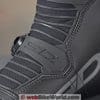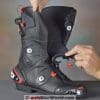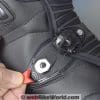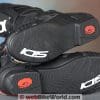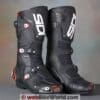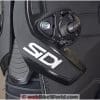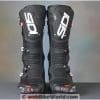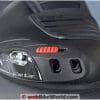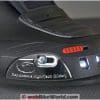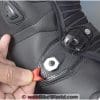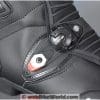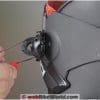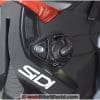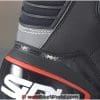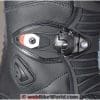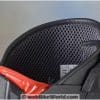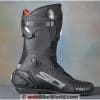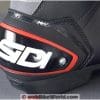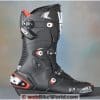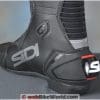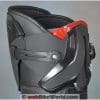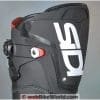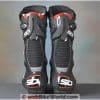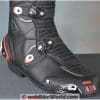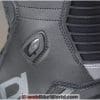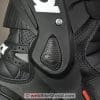The new Sidi Mag-1 boots are top-of-the-line race boots loaded with technology and new features.
They’re sort of a slimmed-down evolution of the Sidi Vortice boots (review) but made lighter (claimed 17%), much easier to wear and they’re also very comfortable, even for street use.
New features include a redesigned “Tecno-3” ratcheting micrometric closure system that is easier to use.
It now includes magnets to hold the keepers and vinyl-coated stainless steel wires in place of the monofilament of the Vortice boots.
The exterior of the Mag-1 boots is more profiled than the Vortice boots; new carbon fiber support beams that prevent lateral flex have been moved to the inside, reducing external bulk.
The shock-absorbing rear heel protector has also gone on a diet with a sleeker design, as has the inside section of each boot to provide better contact with the bike and improved aerodynamics.
Even the interior of the Mag-1 boots has received a makeover, with a new 3D-type liner that is more comfortable than other Sidi boots.
But probably the most impressive result of this evolution is the amount of fore/aft flexibility made available by the ladder-type front and rear flex panels.
The panels make the Mag-1 boots very comfortable to wear — more comfortable, in fact, than any other full race boots we’ve reviewed and even more comfortable than many street or touring boots.
The reflective tape in the rear hints at the fact that the Mag-1 boots are not just for racing; they’re also among the most protective yet comfortable motorcycle boots available for street and sport riding too.
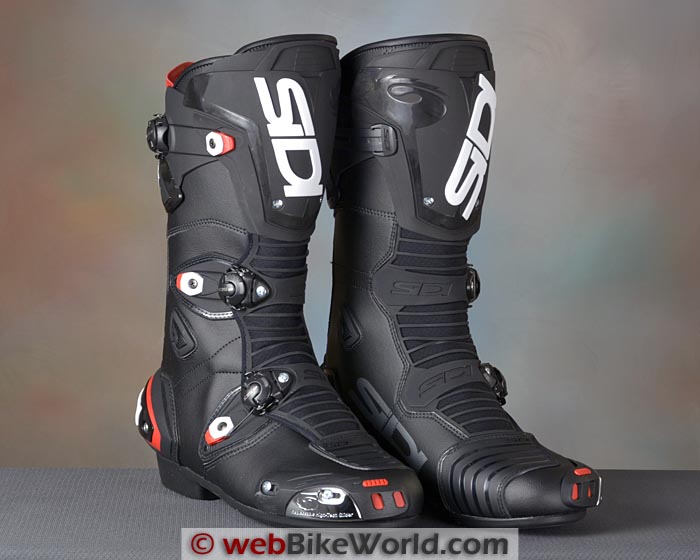


The Sidi Mag-1 Boots
Sidi makes — and sells — more boots “than you can shake a stick at”, as the saying goes. And the world’s leading motorcycle boot and shoe manufacturer isn’t one to rest on its laurels, either.
The new Mag-1 boots were announced in the Spring of 2014 as a new motorcycle racing boot and an evolution of the Sidi Vortice boots (review), which are still in the lineup.
But while the Vortice boots were — and are — the all-out, no-compromise motorcycle racing offering, the idea of the Mag-1 boots was to provide race levels of protection but in a more “friendly”, more comfortable, lighter-weight format.
The Vortice boots now look a bit clumsy in comparison; thicker around the middle, certainly heavier and certainly too much of a chore to lace up for street use.
Rumor has it that Sidi use a lot of input from World Superbike and MotoGP racers to develop the Mag-1.
They wanted a slimmer boot with better contact feel on the inside, towards the bike, along with more front/rear flexibility and more interior comfort. And while you’re at it, Sidi, don’t compromise on protection!
The result is the Mag-1, which exceeds all of those requirements and more.
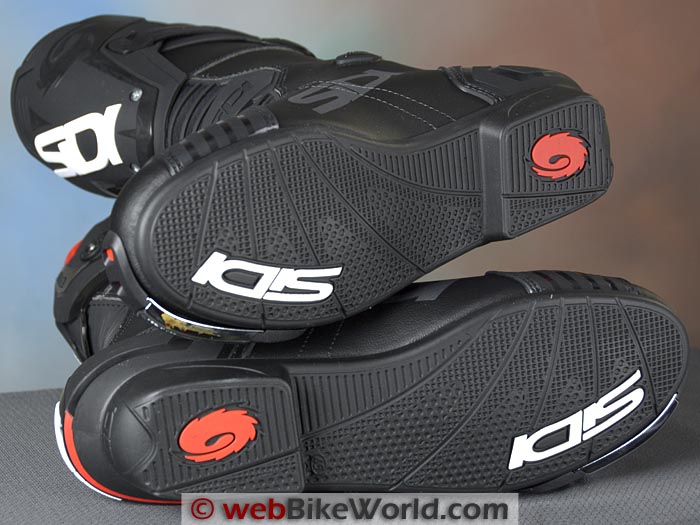

Mag-1 Boots Technology
The Mag-1 boots are made from the Sidi “Technomicro” synthetic leather, which apparently provides more abrasion resistance and more consistency (absence of natural flaws) than real leather.
As with most motorcycle race boots, TPU (thermoplastic polyurethane) is used liberally throughout for protection. Most of the TPU inserts on the Mag-1 boots are owner-replaceable, should they ever get worn down during your Marc Marquez-like corner leans.
The front and rear upper protectors are made from the polyurethane and attached to the boot body with two screws in front. Lateral stiffness comes courtesy of internal carbon fiber “beams” on either side, replacing the thicker external exoskeleton of the Vortice boots that served the purpose.
The beams are hidden under the liner and attached on the inside with a screw under the replaceable ankle slider on the inside and with the screw that holds the middle clip for the “Tecno-3” micrometric closure system on the outside.
The boots have a nylon inner sole and removable arch support padding, along with a dual-compound sole. The boots are double-stitched in the stress areas and some of the stitching on the TPU protectors is recessed in the molding.
The shin protector, heel protector, the Tecno-3 closures and the toe slider are owner-replaceable and the screws have been recessed to prevent wear and scratching. Both boots have a large TPU shift pad on the toe with ribs to ensure traction.
The soles are full race boot style: very stiff and with excellent lateral torsion control. Sidi says the soles are dual compound and they feel “sticky” on the street. The toes have hardened insert protectors also to make them very protective.
There has been no compromising in the Mag-1 boots, so don’t get the idea that just because they’re comfortable that they’re not protective; they include all of the full race features required for the track.
The perforated liner is all new; it’s a “3D” type that promotes air circulation. Sidi says that the liner is nylon and it has been treated with Teflon. The lower part of the lining is Cambrelle and this helps improve comfort also.
The toe slider is nylon also, reinforced with fiberglass, according to Sidi. It has a slider in front that opens dual air intakes on each toe that flow air directly into the boot (see the video).
Tecno-3 Magnetic Closure System
Those Tecno-3 closures have also been redesigned since the Vortice; they’re now in their third generation, as noted by the “3”.
The body of the rotating closure now folds up so you can squeeze both spring-loaded release buttons, pull open the hinged Tecno-3 ratchet and the new vinyl-coated stainless-steel cable releases completely.
A magnet in the pyramid-shaped “keeper” holds it on the “hook” section of the Tecno-3 system; a good idea that is also an improvement.
As you can see in the video below, using the Tecno-3 closures is easy to do and can even be accomplished with one hand, a significant improvement in wearability and “user friendliness” over the original Sidi Tecno closure design. It also allows you to customize how snug you’d like the lower portion over the arch, the middle and the calf section.
The monofilament introduced on the Vortice boots has been replaced with vinyl-coated stainless steel wire, an excellent idea that no doubt improves security while avoiding the tendency of monofilament to twist and basically misbehave.
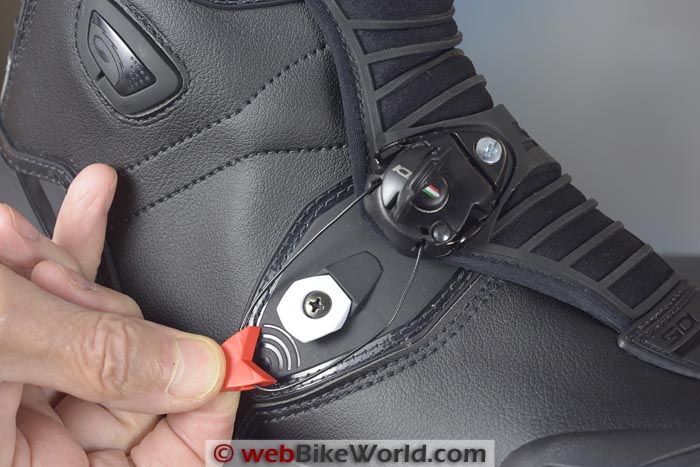


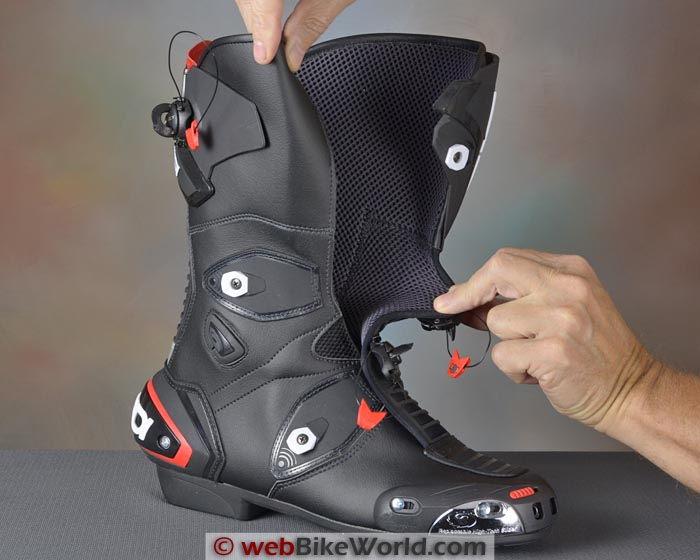


“Comfort” and “Motorcycle Race Boots”: No Longer an Oxymoron!
The most prominent front and rear feature of the Mag-1 boots are the new front arch and rear Achilles tendon panels that use a specially designed Sidi elastic textile with the injection-molded polyurethane “ladder” type support.
Sidi calls these “comfort panels” and they sure are; in fact, I think this is the most significant part of the new Mag-1 boots because along with the new liner, this makes the boots very comfortable to wear for street riding.
This came as a complete surprise and actually somewhat of a shock to me, since most of the sharply-focused motorcycle race boots feel more like torture devices for street riding. I never thought I’d use the words “comfortable” and “motorcycle race boots” in the same sentence, but there you have it.
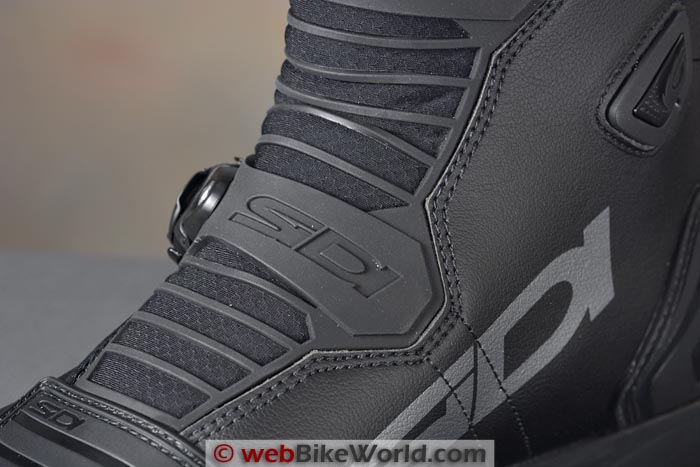


Sidi Mag-1 Boots Fit and Sizing
The Mag-1 boots are available in black or (mostly) white versions, in sizes ranging from 41 (7.5 US) to 47 (12.5 US). Each size 45 shown here weighs 1064 grams (2 lbs., 5½ oz.) which is 17% lighter than a similar-sized Vortice boot, according to Sidi.
This size 45 fits as expected; it’s equivalent to a US size 11 boot and perhaps very slightly narrow. I’m a US size 10.5, which is borderline between a Euro 44 and 45 but this time I went with the 45’s and I’m glad I did.
With the forward/aft flexibility of the Mag-1 boots (more on this in the next section), the extra toe room is welcome, as I normally butt up against the toes of a size 44 boot anyway.
Calf Diameter Notes
One of the most common complaints about motorcycle racing boots is the poor adjustment for width at the calf.
The Mag-1 boots have addressed this with a tooth-type adjuster belt along the top that opens the calf section to fit up to a 15-inch calf diameter 11.5 inches up from the bottom of the heel, according to Sidi.
I sometimes have problems with calf fitment on motorcycle boots, even though I wouldn’t call my calves very large. But, I do a lot of walking and hill climbing so there’s some muscle for sure down there.
No problem at all fitting the Mag-1 boots though, even over a pair of leather race pants, as you can see in the video.
I didn’t have to adjust the toothed width belt that fits along the outside of each boot along the top, so there’s plenty more room for adjustment if needed.
Conclusion
The Sidi Mag-1 boots are surprisingly comfortable and that is the first thing I noticed about them. Other than what some might consider an over-the-top look for street or touring wear, the Mag-1 boots have all the protection you need and better comfort than most motorcycle boots of any type.
The new Tecno-3 closure system is much easier to use than previous versions and it now really does allow a custom fit at the arch, ankle and calf.
Dial in just the right amount of snugness for your personal comfort and you’re good to go, all with an amount of fore/aft flexibility that you just won’t find in other race boots.
The new lining material also helps in this regard and even the red liner at the top of each boot helps protect the back of the calf from chafing.
Some motorcyclists will scoff at the idea of wearing full-on race boots on the street, but we’ve received many emails from riders who have gone through a crash and now want the best protection money can buy.
If that’s you and if you’ve avoided race boots in the past due to their clumsy fit and uncomfortable feel, I say it’s time to try a pair of the new Sidi Mag-1 boots and I think you’ll be surprised.
|
wBW Review: Sidi Mag-1 Boots
|
|
|---|---|
| Manufacturer: Sidi U.S. Distributor: Motonation |
List Price (2014): $495.00 |
| Colors: Black, White. | Made In: Italy |
| Sizes: 41-47 Euro (7.5 – 12.5 US) | Review Date: September 2014 |
Note: Item provided by a retailer, distributor or manufacturer with these Terms and Conditions.
Owner Comments and Feedback
See details on submitting comments.
From “G.B.” (October 2014): “I weighed one each Sidi Vertebra, Vortice and Mag-1: 850 g, 1025 g and 1071 g, so the claimed 17% lighter is a bit of a mystery.”
From “S.H.” (September 2014): “My understanding is this boot does not offer hyper extension/flexion protection. Is this true and if so should I be concerned? I’m trying to decide between these and the Alpinestars SMX Plus, I just want a boot that provides the best protection for daily use on the road.
Editor’s Reply: I discussed this with Sidi and I’ll paraphrase what I was told. They said that the Mag-1 was designed to offer good protection at a very light weight. It was not intended to be as protective as the Sidi Vortice boots (review).
The design of the Mag-1 does not limit rearward flexing; Sidi said that in their research and discussions with medical experts, the consensus is that very few motorcycle injuries happen in this direction.
The side-to-side flex in the Mag-1 is limited but isn’t as firm as the Vortice. However, it’s equal to or better than most other top end race boots.
Sidi wanted to have 2 high end race boots: Ultra protection with the Vortice at the expense of higher weight and light weight in the Mag-1. So there are some compromises vs. the Vortice, according to Sidi, but not vs. many competitors.


